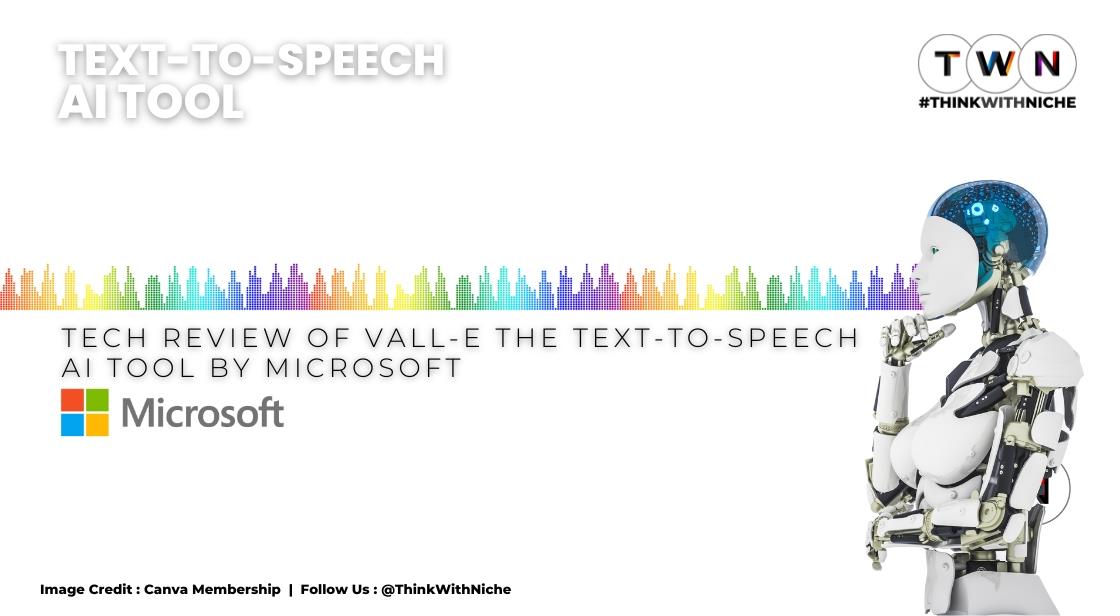Tech Review Of VALL-E The Text-To-Speech AI Tool By Microsoft

Blog Post
The tech sector has long been fascinated by artificial intelligence (AI), highlighting both its positive and negative aspects. When used correctly, programs like Chat GPT and DALLE 2 can be quite beneficial in our working lives. Some users, on the other hand, find artificial intelligence (AI) applications like Replika unsettling.
It is uncommon to discuss technology without mentioning AI. Despite its penetration into the technical world, artificial intelligence is still not fully understood or in use. Chat GPT and DALL E 2, for example, are now available and can be extremely useful if used correctly. Several of these AI applications, however, have the potential to be exploited.
There has been a lot of buzz in recent days about Microsoft's AI initiative, VALL-E. It simply takes three seconds for this application to duplicate someone's voice. Microsoft refers to this tool as "Text to Speech Synthesis Language Model" on the demo website.
Text-to-speech (TTS) AI has been able to ease operations and aid in multitasking in various fields, including healthcare and education.
This article will provide a Tech Review Of VALL-E The Text-To-Speech AI Tool By Microsoft.
Consider voice bots screening COVID-19 patients in limited in-person contact circumstances, easing the strain on physicians. Consider areas where it is an enabler, such as facilitating reading or assisting people with disabilities. And who better than Stephen Hawking to use software via a synthesised speech on his computer, and that, the late physicist's voice, may now be accessed by many? TTS is a common assistive technology in which a computer or tablet reads out loud to the user the text on the screen.
As a result, this device is popular among children who struggle with reading, particularly those who have trouble with decoding. TTS can convert written text on a computer or digital device into sound. TTS is beneficial for children who have difficulty reading, but it can also help them write, edit, and pay attention. It enables any digital information, regardless of format, to have a voice (application, websites, ebooks, online documents).
Furthermore, TTS systems provide a unified method for reading text from mobile devices and desktop computers. These solutions are gaining popularity because they provide readers with a high level of ease for both personal and business applications. Microsoft has recently launched a new TTS strategy. VALL-E is a neural codec language model developed by Microsoft.
Tech Review Of VALL-E The Text-To-Speech AI Tool By Microsoft
What exactly is Microsoft's VALL-E?
Microsoft has developed a new language model called VALL-E. This is text-to-speech technology, and VALL-E will modify your voice so that the speech sounds natural. Consider how simple it would be for everyone!
If you're having difficulty expressing yourself, consider VALL-E instead! VALL-E can synthesise personalised speech while keeping the emotion of the speaker cue. Emotional Voices Database samples are used in the audio prompts.
According to Microsoft, the AI programme also records the speaker's and the environment's emotions. This means that a three-second audio sample is enough to capture the same tone and voice.
Microsoft is also aware of the risks associated with incorrect use. VALL-E is already capable of recording speech. This increases the risk of utilising it to imitate someone else's voice. The company says that such a protocol will be implemented into the system to ensure that the speaker's voice is only used when it is permitted.
The AI tokenizes speech before constructing waveforms that sound like the speaker while keeping the speaker's timbre and emotional tone. According to the study report, VALL-E can synthesise high-quality, personalised speech using only a three-second enrolled recording of an oblique speaker as an audio stimulus. To obtain the desired outcomes, no additional structural work, pre-planned acoustic features, or fine-tuning is required. It is useful for zero-shot TTS systems based on prompts and contextual learning.
Also Read: Unlocking The Potential Of ChatGPT For Content Marketing: A Step-By-Step Guide
Existing methods of TTS
Existing methods TTS techniques are now characterised as cascaded or end-to-end. Cascaded TTS systems, which typically utilise an acoustic model, were developed in 2018 by researchers from Google and the University of California, Berkeley. In 2021, Korean academics, in collaboration with Microsoft Research Asia, suggested an end-to-end TTS model to simultaneously optimise the acoustic model and vocoder in order to address the vocoder's inadequacies. In practice, though, it is preferable to match a TTS system to any voice by entering unusual recordings.
As a result, there is increased interest in zero-shot multi-speaker TTS solutions, with the majority of research focusing on cascaded TTS systems. Baidu Research, California researchers suggest methods for speaker adaptability and speaker encoding as pioneers. In addition, the Taiwanese researchers use meta-learning to improve speaker flexibility, which requires only five training instances to develop a high-performing system. Similarly, techniques based on speaker encoding have made great progress in recent years.
A speaker-encoding system consists of a speaker encoder and a TTS component, with the speaker encoder pre-trained on the speaker verification task. Later, in 2019, Google researchers demonstrated that the model could provide high-quality outputs for in-domain speakers using only three seconds of enrolled recordings.
Similarly, in 2018, Chinese researchers used advanced speaker embedding models to improve the quality of unseen speakers, which still has to be improved. Furthermore, in contrast to previous work by Zhejiang University researchers in China, VALL-E maintains the cascaded TTS legacy while using audio codec code as intermediate representations.
It is the first to offer GPT-3-like in-context learning capabilities without the requirement for fine-tuning, pre-designed features, or a sophisticated speaker encoder. How does it function? VALL-E provides audio demos of the AI model in action. One of the samples is a three-second audio cue known as the "Speaker Prompt," which VALL-E must reproduce. The first example, labelled "Baseline," is typical of traditional text-to-speech synthesis, whereas the second, labelled "VALL-E," represents the model's output.
VALL-E outperforms the most advanced zero-shot TTS system on both LibriSpeech and VCTK, according to the evaluation results. Additionally, VALL-E produced cutting-edge zero-shot TTS outcomes on LibriSpeech and VCTK. Challenges VALL-E has come a long way, however, the researchers say it still has the following issues:
Various problems with VALL-E
- The study's authors remark that speech synthesis occasionally creates confusing, missing, or redundant words. The primary cause is that the phoneme-to-acoustic language section is an autoregressive model, which means there are no constraints on solving the problem, resulting in disordered attention alignments.
- There is no amount of training data, not even 60,000 hours of it, that can account for every possible voice.
- This is especially true for speakers with accents. Because LibriLight is an audiobook dataset, the majority of utterances are read aloud. As a result, the variety of speaking styles must be expanded.
- To forecast codes for various quantisers, the researchers have shifted to utilising two models. Forecasting them using a broad universal model is a promising next step.
- Misusing the model may provide risks due to VALL-ability E's capacity to synthesise speech while keeping speaker identity, which could result in situations such as voice ID spoofing or impersonation.
Conclusion
In recent years, neural networks and end-to-end modelling have enhanced voice synthesis. Cascaded text-to-speech (TTS) systems currently use vocoders and acoustic models as intermediate representations, with mel spectrograms serving as intermediate representations. Current TTS systems are capable of generating high-quality speech from a single speaker or a panel of speakers.
TTS technology has also been integrated into a variety of software and devices, including navigation apps, e-learning platforms, and virtual assistants such as Amazon's Alexa and Google Assistant. It is also used to make encounters more fascinating and relevant to the individual in advertising, marketing, and customer service.
You May Like
EDITOR’S CHOICE












